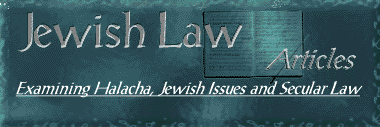

Jewish Law and Copyright
Rabbi Israel Schneider
Until now, we have dealt primarily with the concept of the "protectionist" copyright - granted to a publisher to insure him against staggering financial losses. We will now present four halachic principles which are employed in providing copyright protection to the creators of original works. Interestingly, rabbis may approach the issue from radically differing perspectives and nevertheless arrive at similar conclusions. Thus, although Rabbi Benet argues against the efficacy of bans, he ultimately agrees with Ramo to ban the Justinian edition of Mishneh Torah, for he reasons that Rabbi Katzenellenbogen's edition -- by dint of its explanatory notes, corrections, and comments -- should be deemed to be original and thereby worthy of copyright protection. An even more startling example of this dichotomy is the inclusion of a ten-year printing ban in the introduction (written by Rabbi Benet's granddaughter's husband, Rabbi Avraham Yitzchak Glick) to Rabbi Benet's own work, Responsa Paras Itot Mordechai.
The Rule Of Benefit And Loss
Rabbi Yechezkel Landau, in his magnum opus Nodah B'Yehuda,9 approaches the copyright issue from the perspective of the Talmudic passage, familiar to any Yeshiva student:
|
One who derives benefit and the other suffers loss [is
liable].10
|
Rabbi Landau ruled that in cases where the author paid for the typesetting, the author retains rights to any reprintings made from those selfsame characters.
|
He [the printer] has caused a great loss [to the
author], for if the printer had not published these
[second] books, there would have been a great
demand for Reuven's [the author's] work [which
included the Talmudic text].... Now, that Shimon [the
printer] has printed [his volumes], these volumes
which are cheap and in great supply will reduce the
demand for Reuven's [the author's] work. Since the
printer has caused the author a financial loss, we
obligate him to pay all that he benefited from the
author's share in the typeset arrangement.
|
Rabbi Zalman Nechemia Goldberg, in an essay published In Techumin,11 writes that the Nodah B'Yehudah's comparison of this case to the Talmudic cases of benefit and loss is a subject of disputi among the earlier commentators. As we shall see, Rabbi Goldberg's point reflects the struggle of both halacha and civil law to deal wIth intangibles as property susceptible of being owned. He argues that although the rule of benefit and loss uneqivocally obligates one who has benefited directly from someone else's property, it is not clear whether this law extends to benefit from the intangibles (e.g. form, arrangement, and composition) that are a product of one's labor and creativity. While the particulars are beyond the scope of this article, Rabbi Goldberg concludes that Rabbi Landau's ruling is consistent with the opinion of Rabbenu Tam,12 and in conflict with that of Rabbi Yitzchak.13
Hasagat Ge'vul
As noted earlier, Rabbi Moshe Sofer wrote many respona concerning the issue of copyright.14 Most of the material, however, deals with the exclusive rights granted to a printer in order to make the printing of Jewish scholary works economically feasible. However, Responsa Chatam Sofer, Choshen Mishpat, no.79, deals with a work of original authorship, and provides another source for the concept of ownership of incorporeal property.
The Chatam Sofer addressed the issue whether Rabbi Wolf Heidenheim, editor of the nine-volume Roedelheim Siddur and Machzor, could prevent others from republishing his prayer books. After a lengthy discussion of printer's rights in general, Rabbi Sofer writes:
|
If the case is so [that limited protection is granted] for
printers of other texts [already in the public domain],
so much more so for one who created a new entity...
for example, the consummate scholar, Rabbi Wolf
Heidenheim, who spent countless hours in the editing
and translation of the Piyutim... and why should
others profit from his creativity? It [our case] can be
compared to the case of the fisherman who by means
of his actions caused the gathering of the fish...
|
The commentators point out that the targeted fish, which is yet uncaught, is common property (hefker). Nevertheless, other fishermen must distance themselves from this fish and must stake out other territories. Rabbi Meir, father of Rabbenu Tam, explains that the fisherman who originally staked out the area baited the net with dead fish. This action of the fishserman resulted in the clustering of other fish in the vicinity of the net. For this reason, the other fishermen are enjoined to steer clear of reaping the profits of their fellow fisherman's labors.17 Hence, a fisherman who placed his bait within the proscribed area is guilty of poaching on the preserves of the first.
Rabbi Sofer draws a rather sweeping, far-reaching principle, based on the "fisherman model." It can be formulated as such: One who has expended effort in the attainment of a certain state (apart and beyond the ownership of any tangible property) is legally entitled to the ensuing profits. Hence, the author who has utilized energies in the creation of work, is no less entitled to enjoy the fruits of his labor than is the fisherman who has assiduously baited his traps.18
In conclusion, Rabbi Sofer finds the antecedent for the protection of author's right under the rubric of "Hasagat Ge'vul" - the legislation promulgated to prohibit the encroachment upon the economic and commercial rights of others.
1 | 2 | 3 | Notes

DISCLAIMER
|
|
Page 2 of 3 |
|